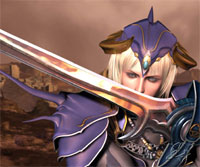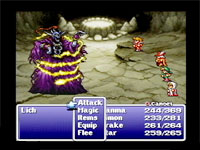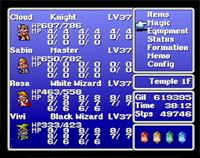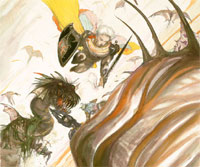




 | 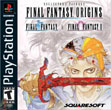 |
| |||||
|
|
Well, it finally came to fruition. After years filled with rumors, changed plans, ditched ideas, denials and confirmations, Square-Enix finally released upgraded, envigorating versions of its two earliest RPGs. In Final Fantasy: Origins, the legendary developer has collected two absolute gems; the scene-altering original Final Fantasy and its sequel, never before released in America, Final Fantasy II. Both have been completely reworked, ironing out several of the nagging faults in the NES originals and providing a much-needed face lift, but have also managed to retain every bit of the magic that made them so interesting in the first place. These games will not wow you with their appearance, nor will they likely appeal to more recent fans of the RPG genre. Instead, they'll provide longtime fans with fond glimpses into their past. The idea of reworking a previous release isn't exactly a novel one. Ever since Super Mario All-Stars brought Mario's extended history to the SNES, major game manufacturers have been attempting to capture their previous bolts of lightning in a new bottle. Tecmo released a fancier collection of its trademark Ninja Gaiden games, both on the SNES and the PC Engine / TurboGrafx-16. Capcom's original frontman, Mega Man, eventually saw his first three titles combined into one cartridge for release on the Sega Genesis (through the ill-fated "Sega Channel.") Even today, titles are reworked and re-released on new platforms, sometimes with frightening speed. The legendary original Metal Gear Solid will soon find a new home on the Nintendo GameCube, while Sega's Shenmue II has already landed on Microsoft's Xbox with a whole bag full of new tricks. Obviously, some have been met with tremendous success, while others have failed pitifully. What it all seems to come down to is the publishers themselves, and their understanding of what endeared the players to their characters in the first place. It's in this aspect that Square-Enix really shines through with Origins. They know what their fans enjoy, and aren't afraid to deliver it. They also know what their fans have disliked about their earlier efforts, and have made appropriate amends in each subsequent release. And, true to their names, these two titles are imbued with a great sense of nostalgia. They reek of "origin" tales, of the sense that something larger is only beginning to stir in the background. The gameplay remains fresh, even today, and merges flawlessly with the looks, feels and occasional functions of the 16-bit era, regarded by many to be the greatest age in the history of the digital RPG. While it's easy to note the lack of polygons, the somewhat primitive attacks and magic effects, and the limited capabilities of such a system, it all functions so well that you'll forget such minor nuances within moments of restarting these familiar quests. The two games in the collection play as differently as night and day. In FF1, you'll find yourself in a familiar position, whether you've played the original or not; you immediately select four characters from a short list of classes, customizing each with only a unique name to distinguish them from the others. Your characters may be any combination of Fighters, Thieves, Black Belts, White, Red or Black Mages, with each possessing various attributes unique to their class. Unlike the original title, where your naming conventions were extremely limited by the four letter per name maximum, Origins allows upwards of seven letters per character. From the selection screen, you're tossed almost immediately into the thick of things, arriving at the game's first castle, briefly retrieving your first quest, stocking up and heading out. Though significant efforts have gone into enhancing and bettering the story, everything still falls into place quite linearly and honestly needs very little explanation. Your characters are very black and white, each featuring strengths and weaknesses that are set firmly in stone. If you've recruited a party of four white mages, physical assaults will never be your strong suit. Likewise, if you've gone completely for brute strength, you'll want to stock up on healing potions. On the other hand, Final Fantasy II introduced players to a pre-set roster of characters, sacrificing the distinct "job" system of the previous title for a much more realistic and well rounded usage-based functionality. You're still given the opportunity to name your initial four characters, but their roles are far less pronounced and truly depend upon your own tendencies as a strategist. If you habitually begin using the female lead in a healing role, she'll gradually become more and more proficient in magic, yet less and less so with physical attacks. The more damage a character takes in battle, the faster his hit points rise. Experience points are completely thrown out of the world of FF2, resulting in an incredible level-raising system that was likely fifteen years before its time. If a next-gen game were released today utilizing this very same syetup, it would be hailed as a remarkable new direction for role playing games. At the time of Final Fantasy II's release, though, it was way too much to deal with. Continuing that trend, FF2 also forged new ground by featuring the first "rotating character" slot in the series' history. Much like in Final Fantasy IV, the first released for the Super NES, characters will join and leave your party when the storyline makes it appropriate. Three of your playable characters always remain constant, as any further departures would cause a serious clash with the character development system, but one slot is always reserved for a temporary ally. It adds a bit of suspense to the storyline, as the idea of a comrade falling in battle for good becomes much more possible and realistic. Visually, the games have taken a great leap forward, but at the same time won't be rivaling their PS2 brother, Final Fantasy X, in terms of sheer beauty. While one part of me wishes this would have been a faithful 3-d reproduction of these familiar environments and situations, another realizes that it just wouldn't have worked as well in polygons. The natural leap from 8-bit to 16 is much, much easier than that next leap into full three dimensions. Besides, if you were born and bred on classics such as Chrono Trigger, Final Fantasy VI or The Secret of Mana (as every self-respecting RPG'er should have been), the visuals of Origins appear as more of a refreshing return to familiar territory than anything else. The old stories fit flawlessly into the mold Square perfected in the mid 90s, and anything more would have detracted from the nostalgia of it all. The attention that's paid to old details is almost frightful, as each enemy is beautifully rendered, yet remains unmistakable from his 8-bit counterpart. Lich, the first game's initial boss, is instantly recognizable, yet looks twice as intimidating thanks to the added touch of color and artistic license. There's more of Yoshitaka Amano's influence in these reworkings of old subjects than there ever was in those original graphics. In the long run, the effort put forth on FF1 looks to have been a little more intensive than that of FF2, yet both stand forward as crowning achievements in the world of pixel-based artwork. As an added bonus, each game has been graced with the addition of a pre-rendered cinema, the kind of thing Square-Enix has become known for, which plays at the very beginning of a new quest. And these aren't the cheap, hastily composed creations that disappointed owners of Final Fantasy's first two anthology titles; they're simply stunning from start to finish. It would appear the art direction team from Final Fantasy VIII was brought in to handle the introductions for both titles in Origins, as the rendered characters themselves bear more than a passing resemblance to Squall, Rinoa, Seifer and company. My only problem with the visuals is more of a strange miscellaneous quirk than anything, but something that I'm finding common with many of Square's current releases. For whatever reason, the entirety of Final Fantasy I doesn't use the entire television screen. It's actually off-center, and though you're given the option to adjust its position, even then it remains about 3% in from the edge of the screen. This wouldn't really be a big problem if I weren't the owner of a projection television, as the constant black borders throw off the set's color balance. This is a major problem I had with the PS2 release of Final Fantasy X, and something I noticed upon review in episodes eight and nine of the same series. Strangely enough, Final Fantasy II... found on the same disc as part one... fills the entire screen without issue, effectively repairing the problem I had with its brethren. But aside from the graphics, the most notable improvement you'll notice in these reworked classics lies within their gameplay. While the very first Final Fantasy for the NES was occasionally marred by slow movement, an odd battle system, bizarre wordings and unexplained status effects, the new releases go to great lengths to repair many of these flaws, and then some. Instantly noticeable (and appreciated) is the addition of a familiar "dash" button. A trend that emerged with the Super Nintendo release of Final Fantasy V, Square has eliminated some of the monotony of wandering through towns, dungeons and the like by allowing players to move through the world at a faster pace, while holding down the circle button. Likewise, in the original releases of Final Fantasies one and two, players would be forced to over-strategize their assaults, as attacking the same enemy with two different party members would result in a wasted attack if the first character to strike killed it. There could be a half dozen other enemies, waiting for a chance to slaughter the party, and the second character would just carry on his way, attacking the empty space where the fallen enemy used to be. Origins tackles the issue effortlessly, merely forwarding that second member's assault to a random enemy when his turn arrives. Another noticeable tweak to the system of both games lies in regards to the status effects system. In the original 8-bitters, attacks such as poisoning, stoning, paralysis and darkness were infuriatingly frequent. It seemed that, no matter how high your resistance, every attack from a certain enemy would yield a poisoning or turn your character(s) to stone. In addition, whenever a member of your roster was the victim of such an effect, the game would instantly move him / her to the bottom of the formation, where they were much less likely to be attacked. While in theory this sounds like a clever, helpful feature, in practice it's far from the truth. Rather than replacing the injured member with the next strongest character in your squadron, the system would instead send the weakest. Every single time. In effect, it did the very last thing you'd ever want it to do, and if you weren't paying attention it was very easy to get caught with your pants down. In this updated release, the latter of those problems are addressed without hindrance. Rather than messing with your formation, the game merely allows everyone to remain where you had placed them, regardless of status effects. If you've run out of antidotes and one of your characters is poisoned, it's completely up to you to move them out of harm's way. On the other hand, the frequency of such effects hasn't been altered a bit. The very same enemies poison your fighters with the very same ease, and the sleep effect is still a major drag. Final Fantasy II addresses this problem in a unique way, providing different levels of poisoning, sleep and paralysis... some of which are broken automatically at the end of a turn. However, despite this apparent gameplay advantage, the second title also suffers from several flaws of its own. No matter the circumstances, in FF2 the enemies will ALWAYS strike you first. Even if you've built the speed of your characters to an insane level, chances are very good that four of your five enemies will be given the opportunity to strike you down before you so much as lift a finger. If you're surprised, or attacked from behind, the enemies get TWO attacks before your first party member carries out his or her orders. If you're lucky enough to gain a "pre-emptive strike," an event which comes around once every hundred attacks or so, your party is actually granted the chance to attack once before suffering any damage of their own, yet has mysteriously lost the ability they possessed in FF1 to effortlessly flee the battle. If this is how combat was carried out on the original NES title, which I've personally never played, I can see why it's still called the most difficult title of the series. Truth be told, without the luxury of "memo" saves, I may not have made it through the game at all. Yes, by far the most notable addition to these titles is the inclusion of a "memo save" feature. Apparently borrowed from the emulation scene's love of "freeze states," a Memo Save temporarily saves your progress to the system's internal memory and is available anywhere, at any time, whether you're on the World Map or deep within a difficult dungeon. The system's only flaw is its complete reliance on the system's power supply. If, for some reason, the power cuts out and you haven't saved directly to the memory card in some time, your progress will be lost. In the long run, though, the risk is worth it and this is a tremendous addition to the functionality of both games, effectively making both much, much easier. Gone is the risk of losing an important boss fight after an hour of dungeon exploration, and losing all of your progress as a result. It really is a handy feature, and one I'm glad to see present here. Finally, the developers should be commended for cleaning up one of the most irritating aspects of the old NES warhorses; their strict, yet inaccessible, restrictions in terms of which party member could equip which piece of armor / weaponry. In the originals, the only way to ensure that the 40,000 gil you'd be spending on that new sword wouldn't go to waste was to unfold the enormous charts that came packed with the game itself for consultation. If these were torn, lost or otherwise damaged over the years, you'd have to rely on guesswork or memory. Origins, however, handles the whole thing masterfully. While browsing the weapons or armor stores, your characters appear at the bottom of the screen. When a specific item is highlighted, each party member who can equip it steps forward, simultaneously displaying whether this new item will enhance or detract from his current equipment setup. The amount of man hours this little feature saves are almost immeasurable, and really makes the game a much more enjoyable play. The music of both titles is one area that I found slightly lacking. While the melodies remain the same, brilliant originals that graced the titles that first time around, the hardware can no longer be blamed for their execution. It's really a shame that Square never moved beyond the realm of synthesized audio and midi-style instrumentation, because their songwriting has always been spot-on. Even today, in the world of DVD audio and dolby digital 5.1 surround sound, they release brand new PS2 games with musical scores that sound less than professional. I've heard much better audio on the PSone in the past, and it's a let down to see that their attention to and enhancement of the details on these old classics wasn't carried over to the music. I'd love to hear an arranged symphony pound their way through these familiar old tunes, and it would've matched the visual and mental enhancements perfectly here. Finally, we come to the most important aspect of any RPG, the story. In this field, the two games on this disc vary wildly. If not for the name, I wouldn't be able to guess these two had anything in common. While Final Fantasy I goes the same route as Dragon Warrior, emotionally detaching your characters from the events themselves and relying entirely on non-playable characters to tell the tale, FF number two involves your party directly. More along the lines of Final Fantasy IV, the title begins as the lead characters' small village is burned to the ground by an insane emperor, and eventually wraps its way around the entire world. Different cultures are a central focus of the story, mass genocide is touched upon and characters, both playable and non, die in several dramatic scenes. And this isn't a hokey "false death," as the series regressed towards with FFIV; it's cold, hard and final. Nobody makes a surprise return from their death bed. It's a much more mature title, a world and a half apart from the innocence and childishness of the first. It remains a step apart from every other title in the series, save perhaps episode seven. In the end, both titles are enthralling and addicting, but FF2 runs about three times as long as its predecessor. While I defeated Chaos, the final boss of part one, in just under eight hours, the final incarnation of the evil emperor in chapter two fell before my blade after twenty-three. They're animals of a different color, sharing in many aspects but standing extremely far apart in others. And, though these are two completely different games, sharing only a title and a few unremarkable similarities with one another, they remain strangely tied to one another, alike despite their variations. Elements of both were used in the molding of Square-Enix's legacy, and each remains an obvious inspiration even today. These are faithful recreations, improving upon many of the old cartridges' infamous flaws, yet strangely ignoring others. The elements of excitement, anticipation and exploration, the foundations of the entire series, have been retained without hesitation while the graphics and sound benefit greatly from the fine tuning. Even the originals' lack of real sidequests and secrets have been accounted for, as both games are accompanied by hundreds of unlockable goodies ranging from original Amano artwork and promotional materials to a complete bestiary and item catalog. As I observed with my review of the very first game in the series, nearly every title in this series carries with it an innocence that's rarely matched. There's a reason Chess and Checkers have been played for centuries without modification, and that same reasoning applies here. This is a steal at the introductory price, an inexpensive peek at the history of the industry through a pair of rose-colored glasses. Overall Score: 9.3 |


